By Molly Lingo M.A., BCBA and Jill Waegeneare M.A., CCC-SLP
Using the Pyramid Approach to Education® to Teach and Expand Functional Communication in the School Setting
 A common concern in public-school settings for children diagnosed with autism spectrum disorder (ASD) and other developmental delays involves challenges in the development of communication skills. We often hear feedback from classroom staff about the lack of time, staff and resources specifically related to implementing Alternative/Augmentative Communication (AAC). At the 2024 ABAI Annual Convention, Molly Lingo, BCBA and former special education teacher, had an exciting opportunity to share data that showed evidence of the effectiveness of the Pyramid Approach to Education® (PAE). Molly shared data that specifically highlighted the base element of functional communication and social skills, where the team targeted teaching and expanding communication. Communication training and expansion were implemented throughout the school environment and in community-based settings including the grocery store, playgrounds and the boardwalk. Staff members not only attended PECS® (Picture Exchange Communication System®) training but also The Pyramid Approach to Education and Teaching Critical Communication Skills training across the school-year.
A common concern in public-school settings for children diagnosed with autism spectrum disorder (ASD) and other developmental delays involves challenges in the development of communication skills. We often hear feedback from classroom staff about the lack of time, staff and resources specifically related to implementing Alternative/Augmentative Communication (AAC). At the 2024 ABAI Annual Convention, Molly Lingo, BCBA and former special education teacher, had an exciting opportunity to share data that showed evidence of the effectiveness of the Pyramid Approach to Education® (PAE). Molly shared data that specifically highlighted the base element of functional communication and social skills, where the team targeted teaching and expanding communication. Communication training and expansion were implemented throughout the school environment and in community-based settings including the grocery store, playgrounds and the boardwalk. Staff members not only attended PECS® (Picture Exchange Communication System®) training but also The Pyramid Approach to Education and Teaching Critical Communication Skills training across the school-year.
Collecting Classroom Data
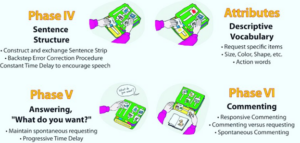 In Molly’s classroom, data were collected on daily use of the Picture Exchange Communication System (PECS) phases IV-VI. Two elementary aged students used PECS
In Molly’s classroom, data were collected on daily use of the Picture Exchange Communication System (PECS) phases IV-VI. Two elementary aged students used PECS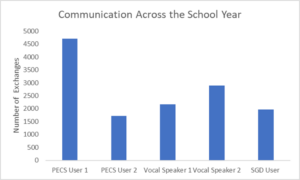 alone, two other elementary students used PECS to augment their spoken repertoire, and one student began the school year ineffectively using a Speech Generating Device (SGD). Regardless of modality, all the learners in Molly’s classroom were diagnosed with a communication disorder and required intervention. Audible gasps were heard at ABAI when the results were presented that 13,450 exchanges were made in one school year! Further analysis showed 18.3% of exchanges were phase VI comments, and 11.6% included the use of attributes for all sentences. Most surprising to the audience was the fact that the PECS users engaged in higher rates of communication than the vocal speakers or SGD users. These results highlight the effectiveness and versatility of PECS in enhancing communication abilities for some of our youngest learners.
alone, two other elementary students used PECS to augment their spoken repertoire, and one student began the school year ineffectively using a Speech Generating Device (SGD). Regardless of modality, all the learners in Molly’s classroom were diagnosed with a communication disorder and required intervention. Audible gasps were heard at ABAI when the results were presented that 13,450 exchanges were made in one school year! Further analysis showed 18.3% of exchanges were phase VI comments, and 11.6% included the use of attributes for all sentences. Most surprising to the audience was the fact that the PECS users engaged in higher rates of communication than the vocal speakers or SGD users. These results highlight the effectiveness and versatility of PECS in enhancing communication abilities for some of our youngest learners.
Analyzing the Results
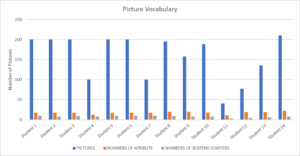 To further emphasize the effectiveness of the PAE, data from a private preschool program in Poland were shared. Similar to Molly’s classroom, this program received comprehensive training in PECS and the PAE. This data focused specifically on PECS use of attributes and distinct sentence starters (I want, I see, I have, etc.) for 14 preschool children with ASD. Results indicated that on average 157 pictures were used per student including attributes and sentence starters. The learners in this classroom were not just requesting with the “I want” sentence starter but were making a variety of comments using an average of 7.9 different sentence starters per learner. Of the total number of pictures in the communication books, 11% included attributes. Overall, the learners in the classroom used a range of 17-22 different attributes which lead to increases in PECS mean length of utterance (MLU).
To further emphasize the effectiveness of the PAE, data from a private preschool program in Poland were shared. Similar to Molly’s classroom, this program received comprehensive training in PECS and the PAE. This data focused specifically on PECS use of attributes and distinct sentence starters (I want, I see, I have, etc.) for 14 preschool children with ASD. Results indicated that on average 157 pictures were used per student including attributes and sentence starters. The learners in this classroom were not just requesting with the “I want” sentence starter but were making a variety of comments using an average of 7.9 different sentence starters per learner. Of the total number of pictures in the communication books, 11% included attributes. Overall, the learners in the classroom used a range of 17-22 different attributes which lead to increases in PECS mean length of utterance (MLU).
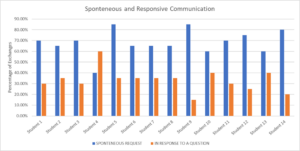 One of the most common myths when it comes to PECS is that it’s only used to teach requesting. This data shows you might be missing out on its full potential when learners move into phases V and VI. Across the 14 learners previously highlighted from Poland, the children were participating in both requesting and answering a variety of WH questions. Some of the WH questions included answering “What’s different?” questions about future and past events, naming objects when given specific characteristics, and answering questions about their age and address. These data include engaging in play with peers, answering questions like "I'm thinking of..." and “Are you thinking of..." These lessons easily lend themselves to teaching responsive and spontaneous commenting. While PECS does help children request things (which is an essential skill!), it offers so much more!
One of the most common myths when it comes to PECS is that it’s only used to teach requesting. This data shows you might be missing out on its full potential when learners move into phases V and VI. Across the 14 learners previously highlighted from Poland, the children were participating in both requesting and answering a variety of WH questions. Some of the WH questions included answering “What’s different?” questions about future and past events, naming objects when given specific characteristics, and answering questions about their age and address. These data include engaging in play with peers, answering questions like "I'm thinking of..." and “Are you thinking of..." These lessons easily lend themselves to teaching responsive and spontaneous commenting. While PECS does help children request things (which is an essential skill!), it offers so much more!
Applying this research to our classrooms
How can you prioritize teaching communication in your classroom?
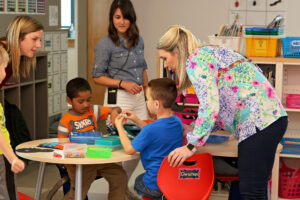
- Have the entire team attend training together
- Inclusion of paraprofessionals and other support staff
- Take time to plan communication across the day
- Slow the lesson down to allow time for students to communicate
- Set goals for minimum communication opportunities per day
- Don’t stay at one phase for too long, keep lessons moving!
- Expect students to continue to build and expand on their current skills
- Be consistent across staff with expectations
Conclusion
 The data shared at the 2024 ABAI Annual Convention highlights the incredible potential of the Pyramid Approach to Education (PAE) and the Picture Exchange Communication System (PECS) in enhancing communication skills for students with ASD. By expanding communication beyond simple requesting to include commenting, answering questions, and engaging in peer interactions, we can create a more dynamic and inclusive environment for our learners. The results demonstrate that with proper training, consistent implementation, and a commitment to expanding communication opportunities, children can make significant strides in their ability to communicate functionally and meaningfully.
The data shared at the 2024 ABAI Annual Convention highlights the incredible potential of the Pyramid Approach to Education (PAE) and the Picture Exchange Communication System (PECS) in enhancing communication skills for students with ASD. By expanding communication beyond simple requesting to include commenting, answering questions, and engaging in peer interactions, we can create a more dynamic and inclusive environment for our learners. The results demonstrate that with proper training, consistent implementation, and a commitment to expanding communication opportunities, children can make significant strides in their ability to communicate functionally and meaningfully.
LEARN MORE:
- Learn more about the Pyramid Approach to Education
- Teaching Critical Communication Skills On-Demand Workshop
- Register for Pyramid Approach and PECS training
- Check out our free materials and resources
Written by Jill Waegeneare M.A., CCC-SLP and Molly Lingo M.A., BCBA
© Pyramid Educational Consultants, LLC. 2024
